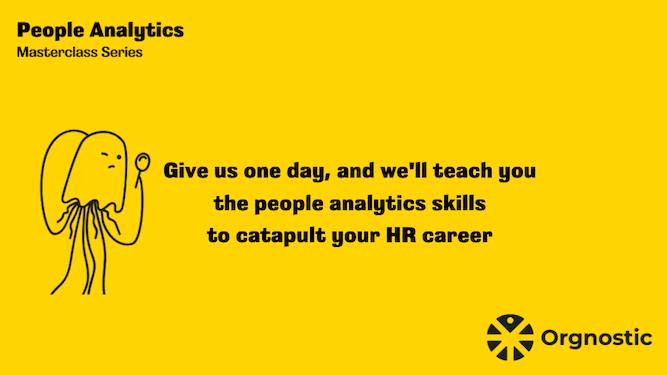Learn how to get started with people analytics and how Orgnostic’s free People Analytics Masterclass Series for strategic HR leaders can help.
Imagine being able to predict which employees are most likely to leave the company, know exactly what you need to do to increase employee engagement, and find out what are the bottlenecks in your recruitment process in minutes.
Analytics make HR (even more) exciting. Its insights are input for strategic decisions and optimization of day-to-day business processes. However, it’s sometimes difficult to know where to start.
Read this post to learn how to get started with people analytics and what you can expect from Orgnostic’s free People Analytics Masterclass Series for strategic HR leaders.

People analytics: where to start?
Every analytics journey starts with a relevant business question or a problem. This is also the best path for making HR a strategic function which supports business goals rather than being a purely operational function.
Measuring the impact of HR on a company’s bottom-line performance is the “holy grail” of HR analytics. However, your mantra with people analytics should be “start small”. Once you get to first insights, action on them and make a change, it is only then that you can showcase the power of using data in driving HR action plans.
People analytics enables you to answer critical questions about your organization. For example:
- How high is your annual employee turnover?
- How much of your employee turnover consists of regretted loss?
- Do you know which employees will be the most likely to leave your company within a year?
These questions can only be answered using data.
Finding answers to people analytics questions
Most HR professionals can answer the first question quite easily.
However, answering the second question is harder since you would need to combine data from two different sources: your Human Resources Information System (HRIS) and your Performance Management System. To answer the third question, you would need even more historic data and regression analysis.
HR departments have a tradition of collecting vast amounts of HR data. Unfortunately, this data often remains unused.
HR has moved from an operational discipline towards a more strategic discipline. When you’re proficient in people analytics, you don’t have to rely on gut feeling anymore.
Analytics enable you to make data-driven decisions. They help you measure the effectiveness of your HR policies and initiatives.
On the other hand, the value that HR analytics brings to you as an HR professional is that it helps you:
- Make better decisions using data
- Create a business case for HR initiatives
- Test the effectiveness of these initiatives
- Move from being an operational partner to a strategic partner to the business
You might be thinking, “yes, this is all great but how do I actually do it and where do I start?”
Just keeping records is often insufficient to add strategic value. You need to turn data into information and information into insights.
Your guide: People Analytics Masterclass Series
In order to help you learn all the basics you need to know in order to get started with people analytics and make HR a truly strategic function in your organization, we’ve designed 8 free People Analytics Masterclass Sessions for strategic HR leaders.
The course covers the following areas:
- May 11: People Analytics foundations
- May 18: Setting up your HR tech stack
- May 25: Data health & data ethics
- June 1: Data-informed HR strategy
- June 8: Answering business questions with data insights
- June 15: How to speak the language of finance
- June 22: Data-based HR scenario planning
- June 29: Stakeholder storytelling with the help of your data
What you’ll learn
1. People analytics foundations – learn about the main pillars of people analytics. Explore the role that HR data, metrics, insights, and reporting play in mastering people analytics.
2. HR metrics – learn how to interpret metrics and get from data to data-driven insights.
3. HR metrics & business – learn how to connect business goals with HR metrics. Use storytelling to make insights uncovered from your data engaging for key stakeholders.
4. People analytics implementation – develop a detailed plan for implementing data-driven HR practices and creating a data-driven culture.
You can attend 80% of the masterclass sessions and get a certificate, or you can handpick the sessions that look interesting to you and attend only these sessions. You will receive recordings of all the sessions.
👉 Ready to get started? Sign up for free->